BioE GAMES Campers Are Exposed to Bioengineering, Engineering's Grand Challenges, & Encouraged to Stay in STEM
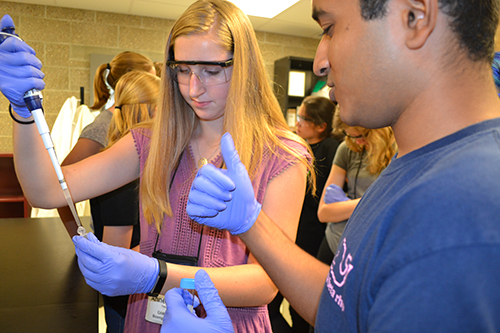
A Bioengineering student (right) supervises a Bioengineering GAMES camper during a lab activity.
September 6, 2017
Besides being exposed to “cool science and engineering stuff,” such as cutting-edge research like quantum dots, according to director Jenny Amos, the 32 high school girls who attended the 2017 Bioengineering (BioE) GAMES camp this past summer were also introduced to some of engineering's Grand Challenges. However, the main intent of the camp, according to Amos, was to encourage the girls to stay in STEM and, hopefully, recruit some of them into Bioengineering.
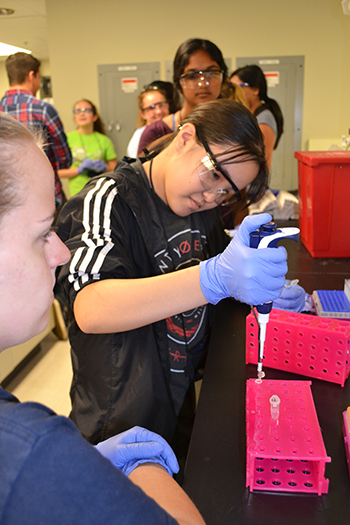
A Bioengineering GAMES camper does a lab activity.
One goal of the one-week BioE GAMES (Girls’ Adventures in Math, Engineering, and Science) camp from July 8–15 was to expose the girls to the broad spectrum of opportunities available to bioengineers. So during the camp, the girls participated in lectures, demonstrations, and hands-on activities related to different types of bioengineering-related research, such as tissue microenvironment, biomimetics, cell patterning, and cardiac physiology. Plus, to help campers see how bioengineering affects medicine, the camp included an all-day field trip to the JUMP Simulation Education Center in Peoria, Illinois, a simulation and training center for doctors to practice life-saving techniques.
Another goal of the camp was to introduce the high school girls to some of Engineering’s 14 Grand Challenges—a to-do list of the 21st century's top engineering challenges if our planet is to survive. Some of those directly related to bioengineering include: reverse-engineer the brain, engineer better medicine, and advance health informatics. So during one camp session, girls were given the opportunity to do a case study related to one of the Grand Challenges.
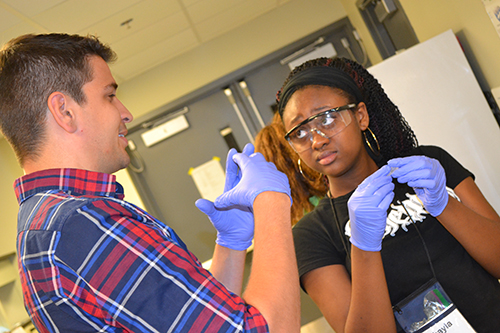
A Bioengineering student (left) interacts with a BioE GAMES camper during a hands-on activity in a lab.
Regarding the BioE GAMES camp's activities, a few years ago, Amos and her former co-director, Olivia Cangellaris, developed the current curriculum, which incorporates lots of hands-on activities, and to which Amos makes slight adjustments every year to strengthen it.
“I think we've hit our stride,” she remarks, regarding the various activities they’ve incorporated. “We've developed the camp; we have a really good model that we're really happy with infusing grand challenges and social science into engineering. That's really unique from even the other GAMES camps. We really talk about girl power and how to persist and stay in STEM; it's part of our mission. And we do cool science and engineering stuff.”
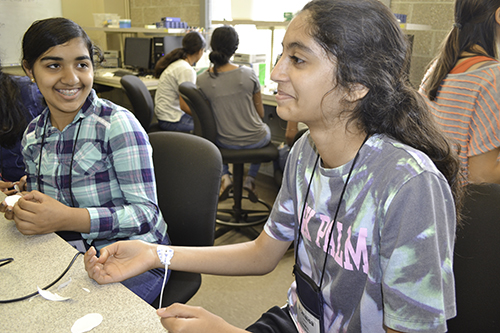
A campers has attached sensors that she and her teammates will use to monitor her vital signs during a Cardiac Physiology activity.
Integral to the conversation about women in STEM are the hour-long group sessions held every day where they break the girls into small discussion groups “to let them reflect on what they learned, and talk about their interests, and talk about women's issues, like persistence in STEM and women's health issues.”
Amos reports that the group of 32 high school girls who participated in the 2017 Bioengineering GAMES camp were from all over the U.S., with the majority being from Illinois. Regarding this crop of campers, Amos reports:
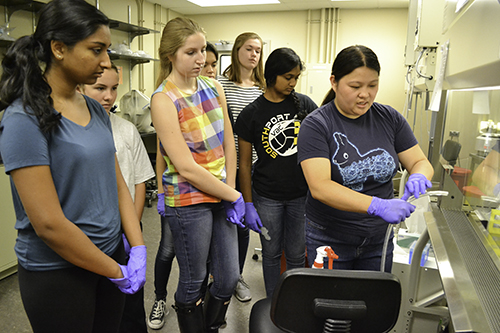
A Bioengineering graduate student (right) shows GAMES campers how to properly prepare equipment they're going to be using in order to do a cell culture.
“This group is very energetic. They seem to be really engaged. They're doing projects this week, and they have some really innovative ideas that they're going to be presenting tomorrow to their parents when they come to pick them up.”
Why does Amos keep doing the camp year after year? For one, she finds it very rewarding each time she encounters a freshman engineering student and recognizes her because she participated in the BioE GAMES camp a few years back, and that’s why she matriculated to Illinois.
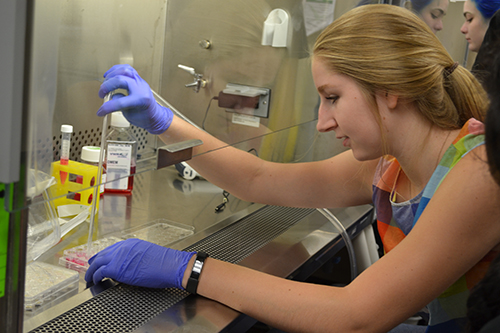
A camper learns to use a pipette during a hands-on activity about cell culture.
“This camp is addictive,” Amos admits. “It's girl power. It's everything fun about being a woman in STEM. And I love that I can see these girls here in GAMES camp, and then I see them actually come to college here pursuing engineering, and it's really fun to see that pipeline of girls continuing through.”
Story and photos by Elizabeth Innes, Communications Specialist, I-STEM Education Initiative.
More: 8-12 Outreach, BioE, GAMES, GAMES: BioE, Summer Camp, Women in STEM, 2017
For additional I-STEM articles about G.A.M.E.S. camp, see:
- Campers Build Model Aircraft, Explore Possible Careers During Aerospace GAMES (2017)
- AERO G.A.M.E.S Campers Soar with New Aerospace Knowledge (2016)
- At G-BAM GAMES Camp Girls Learn They Can Make a Difference Via Engineering (2016)
- High School Girls Discover Chemical & Biomolecular Engineering at GAMES Camp (2016)
- Girls Experience Electrical Engineering First-Hand at the 2016 GLEE GAMES Camp (2016)
- MechSE's WYSE Camp Helps High School Students Explore Mechanical Engineering (2016)
- G.A.M.E.S. Campers Experience Bioengineering—and Have Fun (2013)
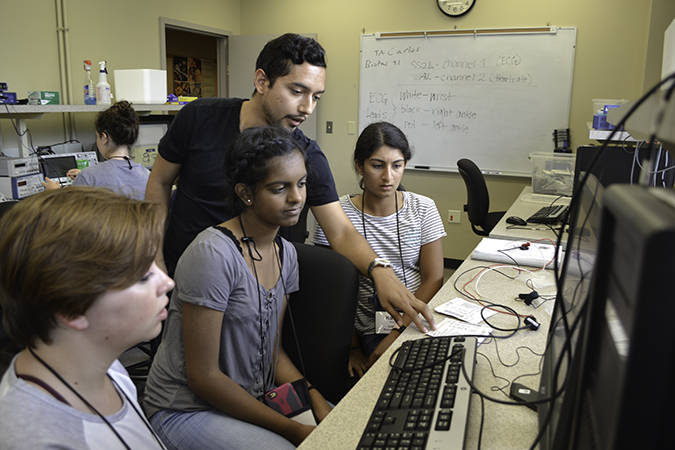
Carlos Renteria, a Bioengineering graduate student (center), works with GAMES campers doing an activity about bioimaging.













.jpg)
















